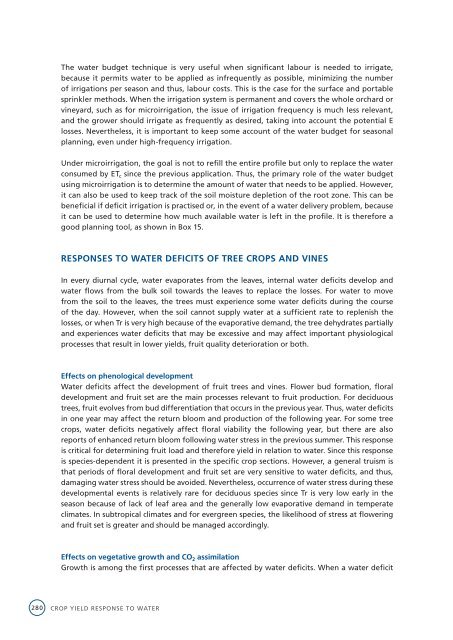Crop yield response to water - Cra
Crop yield response to water - Cra
Crop yield response to water - Cra
Create successful ePaper yourself
Turn your PDF publications into a flip-book with our unique Google optimized e-Paper software.
The <strong>water</strong> budget technique is very useful when significant labour is needed <strong>to</strong> irrigate,because it permits <strong>water</strong> <strong>to</strong> be applied as infrequently as possible, minimizing the numberof irrigations per season and thus, labour costs. This is the case for the surface and portablesprinkler methods. When the irrigation system is permanent and covers the whole orchard orvineyard, such as for microirrigation, the issue of irrigation frequency is much less relevant,and the grower should irrigate as frequently as desired, taking in<strong>to</strong> account the potential Elosses. Nevertheless, it is important <strong>to</strong> keep some account of the <strong>water</strong> budget for seasonalplanning, even under high-frequency irrigation.Under microirrigation, the goal is not <strong>to</strong> refill the entire profile but only <strong>to</strong> replace the <strong>water</strong>consumed by ET c since the previous application. Thus, the primary role of the <strong>water</strong> budgetusing microirrigation is <strong>to</strong> determine the amount of <strong>water</strong> that needs <strong>to</strong> be applied. However,it can also be used <strong>to</strong> keep track of the soil moisture depletion of the root zone. This can bebeneficial if deficit irrigation is practised or, in the event of a <strong>water</strong> delivery problem, becauseit can be used <strong>to</strong> determine how much available <strong>water</strong> is left in the profile. It is therefore agood planning <strong>to</strong>ol, as shown in Box 15.RESPONSES TO WATER DEFICITS OF TREE CROPS AND VINESIn every diurnal cycle, <strong>water</strong> evaporates from the leaves, internal <strong>water</strong> deficits develop and<strong>water</strong> flows from the bulk soil <strong>to</strong>wards the leaves <strong>to</strong> replace the losses. For <strong>water</strong> <strong>to</strong> movefrom the soil <strong>to</strong> the leaves, the trees must experience some <strong>water</strong> deficits during the courseof the day. However, when the soil cannot supply <strong>water</strong> at a sufficient rate <strong>to</strong> replenish thelosses, or when Tr is very high because of the evaporative demand, the tree dehydrates partiallyand experiences <strong>water</strong> deficits that may be excessive and may affect important physiologicalprocesses that result in lower <strong>yield</strong>s, fruit quality deterioration or both.Effects on phenological developmentWater deficits affect the development of fruit trees and vines. Flower bud formation, floraldevelopment and fruit set are the main processes relevant <strong>to</strong> fruit production. For deciduoustrees, fruit evolves from bud differentiation that occurs in the previous year. Thus, <strong>water</strong> deficitsin one year may affect the return bloom and production of the following year. For some treecrops, <strong>water</strong> deficits negatively affect floral viability the following year, but there are alsoreports of enhanced return bloom following <strong>water</strong> stress in the previous summer. This <strong>response</strong>is critical for determining fruit load and therefore <strong>yield</strong> in relation <strong>to</strong> <strong>water</strong>. Since this <strong>response</strong>is species-dependent it is presented in the specific crop sections. However, a general truism isthat periods of floral development and fruit set are very sensitive <strong>to</strong> <strong>water</strong> deficits, and thus,damaging <strong>water</strong> stress should be avoided. Nevertheless, occurrence of <strong>water</strong> stress during thesedevelopmental events is relatively rare for deciduous species since Tr is very low early in theseason because of lack of leaf area and the generally low evaporative demand in temperateclimates. In subtropical climates and for evergreen species, the likelihood of stress at floweringand fruit set is greater and should be managed accordingly.Effects on vegetative growth and CO 2 assimilationGrowth is among the first processes that are affected by <strong>water</strong> deficits. When a <strong>water</strong> deficit280crop <strong>yield</strong> <strong>response</strong> <strong>to</strong> <strong>water</strong>
















